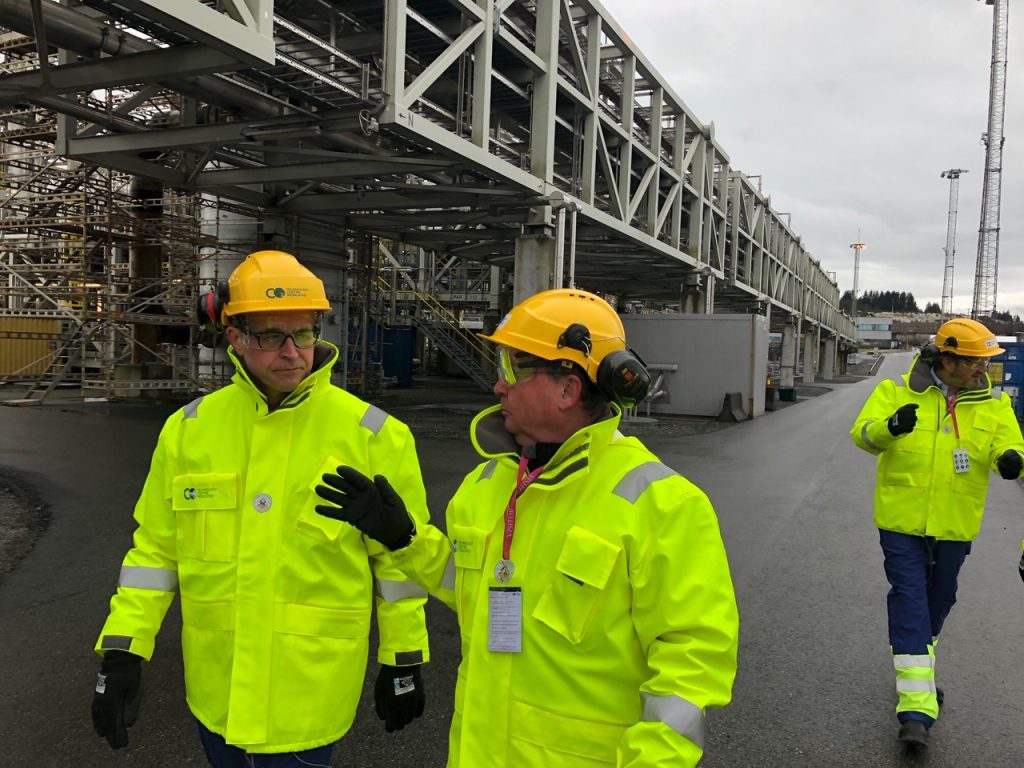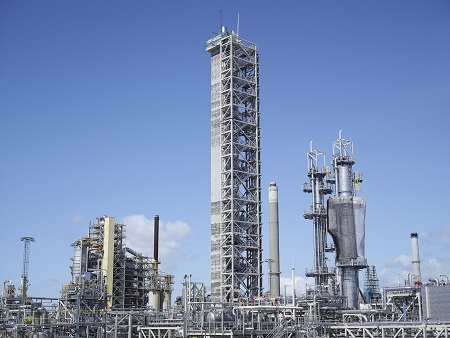Steven Winberg, Assistant Secretary for Fossil Energy in the US Department of Energy (DoE), visited Technology Centre Mongstad (TCM) on Friday 14. February to learn about the new unit for testing emerging carbon capture technologies. The US Department of Energy (US DoE) has long partnered with US companies to test their technologies at TCM in Norway.

TCM is currently the world’s largest and most advanced plant for testing of carbon capture technologies. The technology centre has invested more than USD 3 million in a new test site that will allow testing of new emerging carbon capture technologies. The expansion will be completed in 2020.
The test centre at Mongstad currently consist of two industrial
scale facilities with liquid based technologies. The two main technology
suppliers for the planned full-scale carbon capture projects in Norway, Heidelberg Materials
Brevik and Fortum Oslo Varme, have tested and developed their technologies at
TCM.
The new
site allows for testing of emerging technologies such as membranes or
absorbents (solid materials binding with CO2).
“TCM
has a unique scale and flexibility in terms of ability to simulate real-world
conditions for post-combustion capture and to test a multitude of different
mature and emerging technologies in a cost-effective manner, so that they are
ready for international deployment,” said State Secretary of the Norwegian
Ministry of Petroleum and Energy, Odd Emil Ingebrigtsen, who accompanied his US
colleague during the TCM visit.
Strengthens relations to the United States
In total, eight US technologies are
either already tested or are currently scheduled at TCM. Since 2018, DOE has funded
six US companies for testing at TCM. ION Clean Energy and Fluor
Corporation have already successfully completed their testing. In addition, Membrane
Technology & Research (MTR) and TDA Research have signed agreements to
conduct testing at the new site for emerging technologies at TCM in 2020.
In 2004, the governments of Norway and the
United States signed a bilateral cooperation agreement in the energy
sector, which included carbon capture. The US Department of Energy has been
working very closely with TCM since the plant started in 2012.
“The IEA has stated carbon capture is an
essential piece of any effort to reduce carbon emission significantly and the
energy transition. USA and Norway have a long and storied partnership that will
only continue to grow” said Winberg.
In connection with the establishment of a new test site at Technology Center Mongstad (TCM), the newspaper “Teknisk Ukeblad” (TU) has published an article about on the technology centre and the new test facility which is due for completion in 2020.

The article gives insight into what the new test site will offer and the opportunities it will provide in the future. According to TU; the outcome will hopefully demonstrate more cost-efficient technologies that requires less space and use less energy and thereby be better adapted to the needs of the industry.”
TCM is currently the world’s largest and most advanced plant for verification of the carbon capture technology. In order to maintain plant’s leading position within the CCS-technology, TCM has invested over USD 3 million in a new test site that will be completed in 2020.
The article in TU describes how and why the new test facility is important for further technology development:
“TCM recognise that other technologies for carbon capture is starting to mature. Technologies that potentially are cheaper and more efficient on certain types of flue gases.”
TCM has currently two units that utilize liquid-based technologies (solvents). The new facility will use so-called modular capture technologies such as membranes or absorbents. These new technologies have a lower maturity level and creates further opportunities for technology development.
TU further describes why the new technology testing is important, and quotes Bjørn-Erik Haugan, head of business development at TCM:
“Although the main concern in Norway has been storage of the captured CO2, there is great interest elsewhere to utilize it. If they can find industrial purposes, this can create a cash flow that can cover some of the capture costs. This will arise issues on what kind of characteristics the CO2 should have, depending on the final use. A different technology may give us different results.”
As TU describes, this is one of the reasons why TCM is now investing in a third area for testing of CO2 capture technology. It should be able to receive smaller, modular technology research and thus become a far more flexible solution.
Finally, TU addresses the suppliers of the technology centre, and how the US Department of Energy is heavily involved in the new technology development. There are test centres in the US, but not like the one at Mongstad, and therefore they want to come to Norway to test their technology:
“TCM has several vendors waiting to test their non amine-based CO2 capture technologies. Most are from the US and is financed by the US Department of Energy.”

Technology Centre Mongstad (TCM) and DNV GL have signed a memorandum of understanding (MOU) to support carbon capture technologies.
Høvik/Mongstad, Norway, 23 October 2018 – The world’s largest testing facility for carbon capture, TCM, has signed a collaborative agreement with DNV GL to deliver advisory and verification services for CO2 capture technology. Technology companies carry out advance testing of their carbon capture technologies at TCM and the integration of technology verification will expedite the process of getting new solutions to the market. TCM and DNV GL will offer services to both companies using TCM’s facility and external actors in the carbon capture technology sphere.
“It is vital for us to ensure that carbon capture technology is sufficiently advanced to be used at our facility. Verification and advisory services are a natural progression of the quality assurance measures which we have in place for our collaboration partners that are using TCM’s facility,” said CEO of TCM, Ernst Axelsen.
“We have been working with both CCS and verification of new technologies for the energy sector for a long time. Combining these two capabilities together with TCM is a natural extension of our expertise, says Liv Hovem, CEO DNV GL – Oil & Gas. “DNV GL and TCM will together ensure that the technologies tested and verified at the TCM facilities will be ready for full-scale deployment. While we will ensure the technical feasibility of these technologies, the industry and policy makers together need to make CCS work commercially for it to make a global impact”
DNV GL’s Energy Transition Outlook forecasts that the planet is set to warm beyond the goals set in the Paris Agreement, even though the global energy supply is rapidly decarbonizing. CCS, along with energy efficiency and more renewables, must all be stepped up to prevent the planet from warming to unsustainable levels.
CCS is the process of capturing and storing greenhouse gases from industrial processes, and TCM currently has a focus on the capture stage.
Assistant Secretary for Fossil Energy in the US Department of Energy, Steven Winberg, lectured in front of a full stacked crowd at TCM`s side-event at the conference.

Technology Center Mongstad (TCM) is participating at the world’s largest gathering for Carbon Capture and Storage(CCS) called GHGT-14 in Melbourne, Australia.
Assistant Secretary for Fossil Energy in the US Department of Energy, Steven Winberg, lectured in front of a full stacked crowd at TCM`s side-event at the conference.
This week, TCM will partake at GHGT-14 through stand, workshops, presentations, posters, research papers and meetings. TCM has submitted 6 research papers as main author and 3 papers as co-author to GHGT-14. – We learn a lot from TCM`s open source technology testing and we are continuously sharing the knowledge to advance the entire CCS-community, Technology Manager at TCM, Thomas de Cazenove said.
Over 100 participants at TCM`s event at GHGT-14
On Monday 22. October, TCM arranged a side-event at GHGT-14. Assistant Secretary of Fossil Energy in the US Department of Energy, Steven Winberg, presented in front of over 100 participants about the utility of a CC-plant like TCM. In addition, Hans Jørgen Vinje in Gassnova talked about the development of CCS infrastructure for Europe. Bjørn-Erik Haugan and Anne Berit Viken from TCM presented the unique qualities of TCM and Keith Burnard in IAGHG concluded with final remarks.
The engineering- and construction company Fluor has signed an agreement for use of the test facility Technology Center Mongstad (TCM) in Nordhordland.

– This project will contribute to strengthen the energy technology cooperation between Norway and USA, TCMs business development manager, Bjørn-Erik Haugan says.
Fluor has long history in developing solutions for capturing carbon dioxide (CO2). The company now wants to test a new technology at TCM.
– It is raising global interest that such a world-renowned company as Fluor will cooperate with TCM, which is the world´s largest test facility for carbon capture, Haugan says.
Satish Reddy, Vice President of Process Technology in Fluor, stated that the company wants to test a newly developed chemical (solvent) to separate carbon dioxide from industrial flue gases.
– We believe that the new technology has an exciting potential to advance carbon capture. TCM is an appropriate place for us to conduct the test, Reddy says.
Fluor will use the Amine test plant at TCM during the period December 2018 – May 2019.
Strengthens relations to the United States
Norway and the United States have a bilateral cooperation in the energy sector, including carbon capture. TCM is an important part of the venture. Relations between the countries were further strengthened in February when the US Department of Energy (US DoE) awarded USD 33.7 million to four US companies who aim to test their carbon capture technology projects at TCM.
– Carbon capture has become the most important part of the energy collaboration between Norway and the United States. Fluor follows ION Engineering as the second US DoE funded company using TCM in a test campaign. It is positive for us that US authorities support major companies in their desire to test technologies at our facilities, says Haugan.
About carbon capture and storage
Carbon capture and storage is expected to play a key role in the reduction of greenhouse gases globally. The International Energy Agency (IEA) has estimated that one fifth of total cuts will come from carbon capture by 2050. Carbon capture and storage (CCS) involves three phases. First, the CO2 is separated from the other emission gases and then compressed into a liquid state. This phase is the main focus for TCM. Then, CO 2 is transported to the storage location. Finally, it is pumped into an underground or sub-seabed formation located thousands of meters below surface level.
For further information, please contact:
Bjørn-Erik Haugan, TCM Business Development Manager
mobile 90553394,
e-mail: beh@gassnova.no
Satish Reddy, Vice President, Process Technology at Fluor Corporation
mobile +1 (949) 637 1255,
e-mail: Satish.Reddy@Fluor.com
